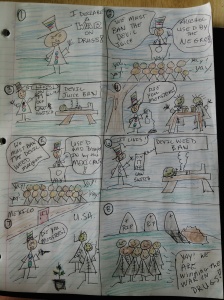Creative Project Justification Week 4
Creative Project Week 4: “Everything Begins & Ends at the Kentucky Club”
PHIL 114
You have permission to post this
The image I have submitted for my creative project is actually a screenshot from a video game I play called “Just Cause 3.” The screenshot is a scene of a modern-day town, similar to what you would find in Juarez, Mexico. On the street, a gruesome gun battle has just taken place, leaving dead bodies and destroyed cars smoking in the aftermath. Two civilians are seen hanging from a telephone pole, likely hung there before the gun battle took place. These two visuals however, are not the most disturbing thing in this scene. On the right you see two women, one old and one young, walking along the side of the road, not even giving the graphic scene a moment’s notice as they continue on with their day. I was inspired to create this scene after reading the conversation between Javier and Carlos on pages 34-35 in the short story “He Has Gone to be With the Women.” In this conversation Carlos attempts to convince Javier to leave Juarez and come live with him. Javier refuses, offering a single line of reasoning for it.
“What would happen if everybody left?” Javier Said.
“Then the city would die.” Carlos replied.
“That’s right, Carlos.”
After reading this I made a very strong connection to some of my own experiences in playing video games. Often times there are sequences of intense action and violence that take place around innocent bystanders. What always caught my attention, because I always found it to be so unrealistic, is how after the action stops and dead bodies, burning cars, and destroyed buildings litter the landscape, all of the people that live there, the innocent bystanders, soon resume the normal activities as if nothing had even happened. Now this is of course because of how they are programmed, but yet is it so unrealistic? Javier refuses to leave a city swallowed by death and destruction. He has a strong connection to that city, and no matter how bad things get, he will not allow the city to die, he chooses to carry on. Suddenly the scene I have seen many times in video games, the scene I have created for this project, has a stinging touch of reality. No longer do they represent goofy AI not reacting to the surroundings simply because of the limitations of their programming. These could be real people, in real cities and towns, who simply choose to, instead of fleeing from their beloved city leaving them and all they love to die in their wake, push forward. They continue to live for what they love, for what they feel connected to.







